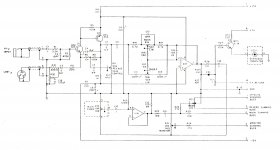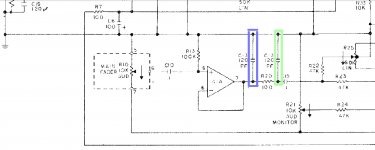Hi All,
I have a problem with a Fender MA6 Mixer Amplifier.
I should mention that it is not a complete unit, it came to me minus its cabinet, power amp and PSU. It has been mounted in a home made cab with a MOSFET power amp and PSU.
The problem appears to be rf oscillation. This only seems to happen on channel 3 & 4 when I turn up the main fader. It manifests itself as a high reading on the vu meter with no sound from the loudspeaker. I did destroy a piezo tweeter and since then have put a 47ohm high wattage resistor in series with the loudspeaker when tried again.
I am thinking that a small capacitor in a negative feedback loop or from the signal path to ground, but would like advice on what value and where would be likely to do the most good.
I was able to get the circuit diagrams for this unit and attach the one for the preamp.
Thanks in advance
Stuart.
I have a problem with a Fender MA6 Mixer Amplifier.
I should mention that it is not a complete unit, it came to me minus its cabinet, power amp and PSU. It has been mounted in a home made cab with a MOSFET power amp and PSU.
The problem appears to be rf oscillation. This only seems to happen on channel 3 & 4 when I turn up the main fader. It manifests itself as a high reading on the vu meter with no sound from the loudspeaker. I did destroy a piezo tweeter and since then have put a 47ohm high wattage resistor in series with the loudspeaker when tried again.
I am thinking that a small capacitor in a negative feedback loop or from the signal path to ground, but would like advice on what value and where would be likely to do the most good.
I was able to get the circuit diagrams for this unit and attach the one for the preamp.
Thanks in advance
Stuart.
Its usually the VAS stage where the capacitor lies for stopping oscillation.
Trying replacing it or if that doesnt fix it try a slightly higher value.
Could be someone has changed output transistors to modern versions and the gain is higher.
I bought in a 1980's Maplin 225WRMS amp and it had the output transistors missing.
So I bought new ones and the amp oscillated badly.
I increased the VAS capacitor and it fixed it.
I then checked the gain of the new transistors and they were way higher than the old specification for them hence the oscillation.
Trying replacing it or if that doesnt fix it try a slightly higher value.
Could be someone has changed output transistors to modern versions and the gain is higher.
I bought in a 1980's Maplin 225WRMS amp and it had the output transistors missing.
So I bought new ones and the amp oscillated badly.
I increased the VAS capacitor and it fixed it.
I then checked the gain of the new transistors and they were way higher than the old specification for them hence the oscillation.
Honestly that sounds more like the newer parts were slower than the old ones. You measured beta/hFE, right? High current gain, too, would support oldish power transistors (low-droop parts only tend to have moderate beta at low currents). The again, stability being stability, it really could go both ways.I bought in a 1980's Maplin 225WRMS amp and it had the output transistors missing.
So I bought new ones and the amp oscillated badly.
I increased the VAS capacitor and it fixed it.
I then checked the gain of the new transistors and they were way higher than the old specification for them hence the oscillation.
All of this has precious little to do with the OP's problem though. He's got some sort of feedback issue where (presumably) the power amp couples back into the mixer at some point. With the cabinet and PSU being new and hence unknowns, it's very hard to tell where the eff-up(s) may be hiding - quite possibly a grounding issue, so that should be double- and triple-checked. Bill Whitlock (I think) described a case where "pin 1 problem" at the inputs alone would send a mixer into oscillation!
In order to say anything more, we would have to have a look at power supply layout and ground routing, and schematics of the whole shebang may also help a great deal.
Hi All,
First, sorry, the circuit diagram didn't get uploaded - I'll try again.
nigelwright7557 - I have tried disconnecting the power amp from the original part and still get the RF oscillation (it could be very high frequency audio) showing on the oscilloscope at the preamp out socket.
After googling around 'opamp' and 'capacitive load', would it be sensible to try moving C3 from it's current position shown in blue to after R20 shown by the green in picture 5?
I did wonder if it would need a metal base panel as an RF screen in the same way as some older PA amps had a sheet of aluminium behind the front panel, between the preamp board and the power amp?
Stuart.
First, sorry, the circuit diagram didn't get uploaded - I'll try again.
nigelwright7557 - I have tried disconnecting the power amp from the original part and still get the RF oscillation (it could be very high frequency audio) showing on the oscilloscope at the preamp out socket.
After googling around 'opamp' and 'capacitive load', would it be sensible to try moving C3 from it's current position shown in blue to after R20 shown by the green in picture 5?
I did wonder if it would need a metal base panel as an RF screen in the same way as some older PA amps had a sheet of aluminium behind the front panel, between the preamp board and the power amp?
Stuart.
Attachments
Currently Rebuilding MA6
"I did wonder if it would need a metal base panel as an RF screen in the same way as some older PA amps had a sheet of aluminium behind the front panel, between the preamp board and the power amp?"
I got my hands on a MA6 mixer and I'm currently ripping it apart. There is a substantial amount of shielding under the input section and between the input and x-former (though you have a new power section) you still may need to isolate the input section for RFI and the like...
"I did wonder if it would need a metal base panel as an RF screen in the same way as some older PA amps had a sheet of aluminium behind the front panel, between the preamp board and the power amp?"
I got my hands on a MA6 mixer and I'm currently ripping it apart. There is a substantial amount of shielding under the input section and between the input and x-former (though you have a new power section) you still may need to isolate the input section for RFI and the like...
- Status
- Not open for further replies.

